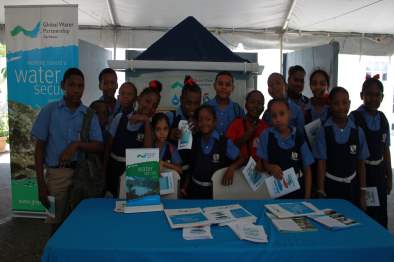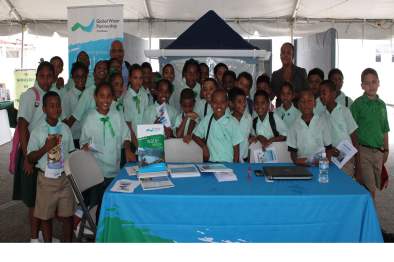GWP-C therefore welcomed the opportunity to participate in the National Institute of Higher Education, Research, Science and Technology’s (NIHERST’s) {a GWP-C partner} recent “Tap into Science Week.” The Science Week which was held from April 20th – 25th, 2015 in Trinidad is a collaboration between NIHERST and the Ministry of Science and Technology of Trinidad and Tobago and is part of NIHERST’s outreach programme aimed at continuing the making of science and technology concepts popular across the country.
At the event, GWP-C had an interactive Rainwater Harvesting (RWH) booth which featured the newly modified RWH model. In 2010 the GWP-C contracted the Caribbean Environmental Health Institute (CEHI) to construct a portable Rainwater Harvesting (RWH) model to demonstrate RWH best practices throughout the Caribbean region.


The new GWP-C Rainwater Harvesting (RWH) model.
The new version of the original RWH model, produced in late 2014, which was premiered at “Tap into Science Week,” showcases a first-flush diverter, which promotes minimising contamination and enhancing the quality of captured and stored rainwater.
The water that is first captured on the rooftop of a RWH system can be tainted with debris from animal droppings and contaminants from poorly maintained roofs. The first-flush system which would form the bottom part of the downpipe is used to divert the initial water collected, ensuring that it does not enter the storage device being used.



Some of the students accompanied by their teachers that visited the GWP-C RWH exhibition booth.
Through the use of the new RWH model, GWP-C was able to directly interact and share knowledge with more than six hundred (600) students between the ages of four and twenty years at the Science Week. The students learnt about the benefits of safe RWH practices and the important role of the first-flush diverter on the model.
Visitors to the GWP-C booth also included persons from the general public and representatives from other exhibiting agencies who all showed a keen interest in the GWP-C RWH model. Visitors were intrigued by seeing the model in action which simulated rainfall on the roof and into the guttering and the first-flush diverter which gave a practical demonstration of how such a system could work when applied on a house or building.
The GWP-C newly modified RWH model was developed under its Water, Climate and Development Programme (WACDEP). GWP-C through its improved RWH model and related activities is committed to sharing knowledge with stakeholders at all levels on best practices in rainwater harvesting in the Caribbean.
Video
Click here to watch a short video of young persons at the “Tap into Science Week” learning about RWH at GWP-C’s booth.
